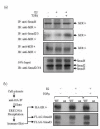Dual effects of TGF-beta on ERalpha-mediated estrogenic transcriptional activity in breast cancer
- PMID: 19943940
- PMCID: PMC2787496
- DOI: 10.1186/1476-4598-8-111
Dual effects of TGF-beta on ERalpha-mediated estrogenic transcriptional activity in breast cancer
Abstract
Background: TGF-beta resistance often develops in breast cancer cells that in turn overproduce this cytokine to create a local immunosuppressive environment that fosters tumor growth and exacerbates the invasive and metastatic behavior of the tumor cells themselves. Smads-mediated cross-talk with the estrogen receptor has been implied to play an important role in development and/or progression of breast cancer. We investigated how TGF-beta regulates ERalpha-induced gene transcription and potential mechanisms of frequent TGF-beta resistance in breast cancer.
Methods: Effect of TGF-beta on ERalpha-mediated gene transcription was investigated in breast cancer cell lines using transient transfection, real-time PCR, sequential DNA precipitation, and small interfering RNA assays. The expression of Smads on both human breast cancer cell lines and ERalpha-positive human breast cancer tissue was evaluated by immunofluorescence and immunohistochemical assays.
Results: A complex of Smad3/4 mediates TGF-beta inhibition of ERalpha-mediated estrogenic activity of gene transcription in breast cancer cells, and Smad4 is essential and sufficient for such repression. Either overexpression of Smad3 or inhibition of Smad4 leads to the "switch" of TGF-beta from a repressor to an activator. Down-regulation and abnormal cellular distribution of Smad4 were associated with some ERalpha-positive infiltrating human breast carcinoma. There appears a dynamic change of Smad4 expression from benign breast ductal tissue to infiltrating ductal carcinoma.
Conclusion: These results suggest that aberrant expression of Smad4 or disruption of Smad4 activity lead to the loss of TGF-beta suppression of ERalpha transactivity in breast cancer cells.
Figures




References
-
- Jaiyesimi IA, Buzdar AU, Decker DA, Hortobagyi GN. Use of tamoxifen for breast cancer: twenty-eight years later. J Clin Oncol. 1995;13:513–529. - PubMed
Publication types
MeSH terms
Substances
Grants and funding
LinkOut - more resources
Full Text Sources
Medical
Miscellaneous

